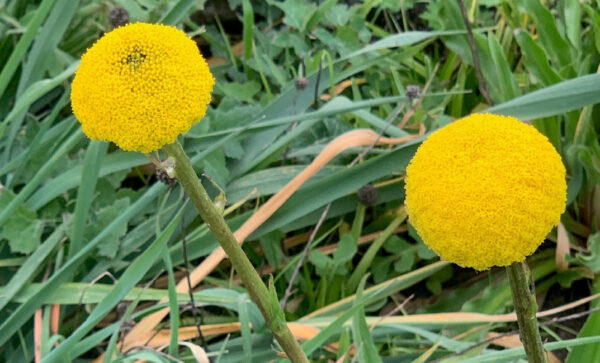By Sian Watkins
You would not believe how much splendour exists in deceptively motley-looking blocks of grassland in St Albans and Cairnlea. Walk through them with Rick van Keulen and he helps you see all the different, often winsomely-named plants, such as featherheads, button wrinkleworts, golden billybuttons and showy podolepis, many of which have begun to flower.
There’s not a plant in the 34-hectare Iramoo grasslands that Rick wouldn’t know the name of. More impressively, he can spot the difference between native grasses and noxious serrated tussock and Chilean needle grass from ten paces.
The Iramoo grasslands behind Victoria University’s St Albans campus are among the remaining fragments of the volcanic grasslands that stretched from Merri Creek to South Australia until Europeans arrived. On the city’s western outskirts, people, weeds, rubbish and chemicals keep obliterating or further damaging the plain.
The Iramoo Grasslands are managed by the Cairnlea Conservation Reserves Committee of Management and Friends of Iramoo. They also manage the four-hectare Featherheads Grassland in Cairnlea and Pimelea Wildflower Reserve in St Albans.
Rick has led the friends’ group’s efforts to remove serrated tussock and other weeds from the Iramoo site. He shows me pictures of an impressive burnoff of serrated tussock seed in 2020, which he collected using a tractor and header. It burns much more intensely than native grasses.
The grasslands were largely treeless because “the lava flows [from massive volcanic eruptions over the past six million years] wiped them out,” Rick says, stepping expertly through a small section recently replanted with native geraniums and Pimelea curviflora.
Rick is a former carpenter, wheat grader and youth worker who got into ‘environmental stuff’ in the early 1990s. He grew up in St Albans. His family were campers and he always liked being in the bush. “I played in these areas as a kid. I feel very connected to it. We used to fish and camp along the Maribyrnong, where Brimbank Park is. There were caves down there, with indigenous artefacts. They filled them in in the 1970s.’’
I played in these areas as a kid. I feel very connected to it. We used to fish and camp along the Maribyrnong, where Brimbank Park is. There are caves down there, with Indigenous artefacts.
His commitment to native grasslands in the face of vandalism, piecemeal funding for biodiversity protection, ineffectual environmental protections afforded by the law and land-clearing offsets, and public ignorance about grasslands ecology, is admirable. He gets demoralised at times (“I buck up a bit when we get a grant”) but tries to deal with it in the same way he has dealt with serrated tussock – “you keep your head down and keep spraying. Don’t look up.”
Rick must have looked up on a previous weed patrol because we soon spot serrated tussock and Chilean needle grasses, unyielding among the poa and wallaby grasses. “They’re Ok,” he says. “You can’t get rid of too many weeds at one time because then you lose protective cover [for lizards, frogs, insects] and new weeds blow into the gaps.”
The fence that rings the Iramoo grasslands isn’t fox proof and vandals keep cutting it. Someone blew up all the signs around the perimeter of the site that explained what the Friends of Iramoo were doing and why their restoration and conservation efforts were so important.

“Yep, someone blew them up,” Rick says. “We had the bomb squad down here and the local CIB. We can’t afford to replace them. People come past and complain about the [grass] seeds. They say ‘when are you going to do something with it – it’s a mess. They want a park in here and a path around it.’”
Then there’s the criticism of the fence – people are part of nature, they shouldn’t be excluded from it. “These people obviously haven’t lived in St Albans,” Rick says dolefully. “People dump stolen cars, rubbish. We’re not doing this for people. It’s about protecting the little bit we’ve got left.”
Rick’s father was a boat builder from Rotterdam who emigrated to Australia in 1956. Rick, one of four, was born a year later. The family started out at the Maribyrnong Migrant Hostel, moved to Footscray and then to St Albans when Rick was in primary school. His father’s boat building business was just south of the Dynon Road bridge in Footscray. It closed in the 1970s with the advent of cheaper, fibreglass boats.
Rick remembers the German fellow who worked for his father. He built his own boat from offcuts and one day he sailed it back – down the Maribyrnong to Germany. His telling brings to mind the storybook Max who sails off in the night to Where the Wild Things Are. But unlike Max, the German “couldn’t put his mast up for a while – he had to get under all the bridges”.
Rick started work with his father and when that didn’t work out he went to King Island to work in the underground scheelite mine. He was 18 and went from earning $26 a week to $400 a week. He didn’t save a fortune because the done male thing was to go to the pub after work. “I ended up joining the volunteer fire brigade to give me a distraction.”
He stops talking and beckons me to look up at the sky. If getting news of a grant bucks him up, so does seeing kestrels and black shoulder kites fly over. “It’s fantastic to work here and see things change and the wildlife come back.”
Later, showing me a section replanted with native herbs, a sound stops him. “That’s a common froglet,” he says. “A spotted marsh frog makes a different noise.” He mimics one – “tch tch tch” – and it sounds like Skippy the kangaroo.
To contact Friends of Iramoo:
Web: friendsofiramoograsslands.wordpress.com
Email: iramoo@vu.edu.au
Phone: 9919 2129
Related information is also available at
https://www.brimbank.vic.gov.au/living-here/our-environment/our-natural-environment

